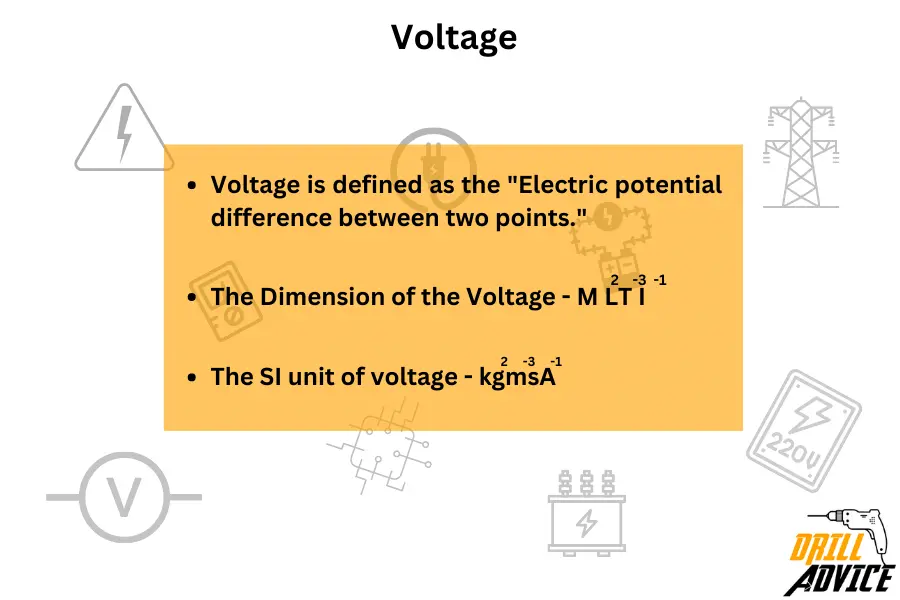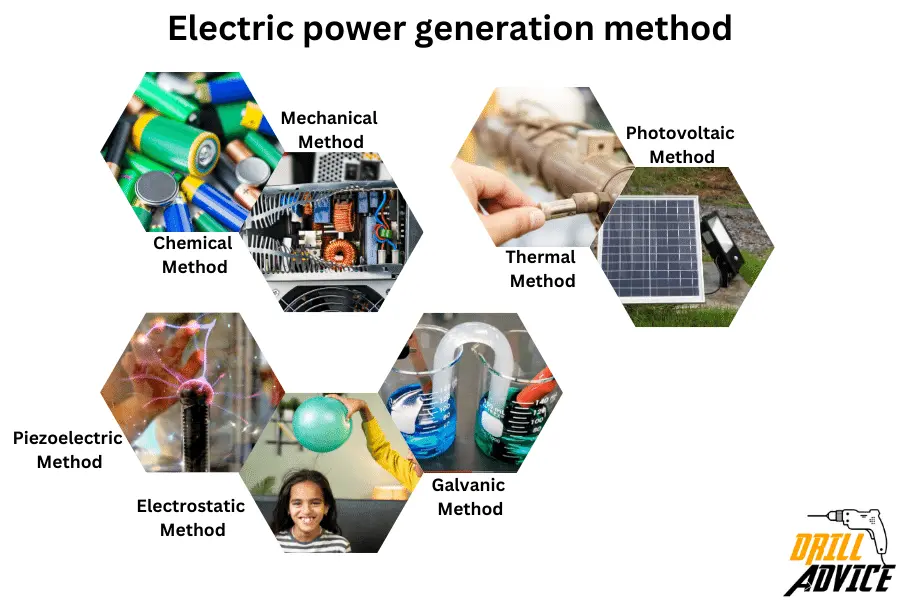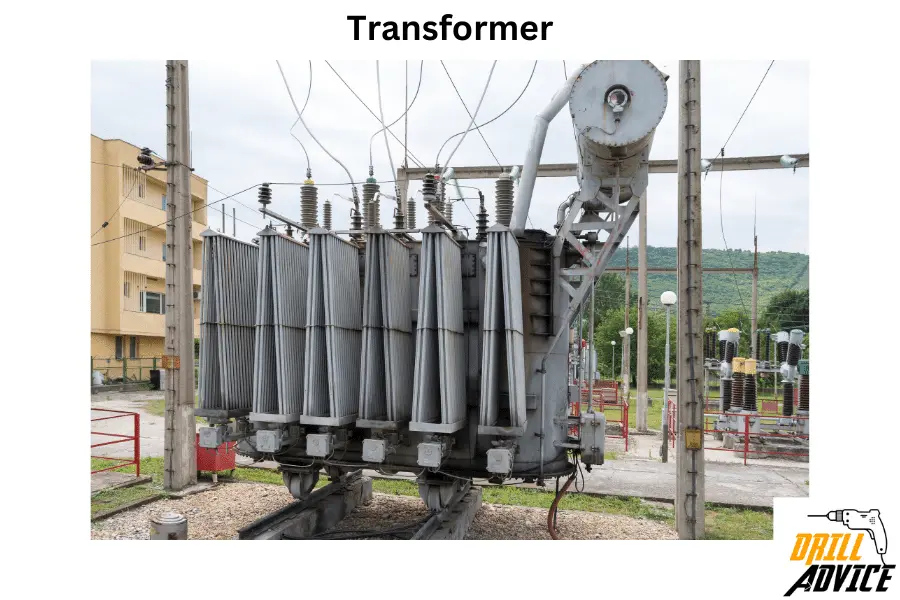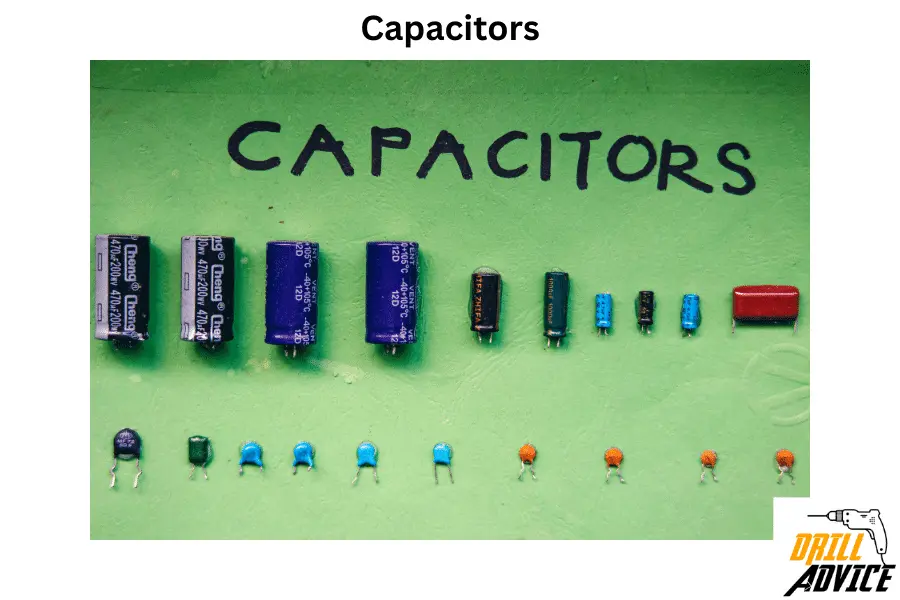
Voltage is an electric potential difference between two points. The symbol of voltage is “V.” Voltage can be expressed as voltage = current x resistance or volt = amps x ohms or V = A x Ω. The units and dimension of voltage is kg⋅m2⋅s−3⋅A−1, M L2 T−3 I−1. Voltage was found by “Alessandro Volta” in 1745. Voltage can be generated, transferred and stored for usage.
The voltage can be generated using these 7 methods such as chemical, mechanical, thermal, photovoltaic, piezoelectric, electrostatic, and galvanic methods. The most popular voltage generation method is the mechanical method using EMF principles.
The generated voltage can be transmitted through the cables by increasing and decreasing the voltage level by using transformers in order to provide the standard domestic consumptions. Voltage is mainly two types such as AC voltage and DC voltage. AC voltage waste less power during the generation.
AC voltage can be converted into DC voltage. This process is called rectification. Voltage can be measured using a voltmeter, but a multimeter and oscilloscope are more precious equipment to measure the voltage.
Ohm’s law states that the “current passing through a conductor between two points is directly proportional to the voltage across the two points when the temperature remains constant”. Current is the flow of electric charge in a conductor. Resistance is the barrier to the electric charge flow. Superconductivity is an ideal conductor with zero resistance.
Capacitors can store electrical energy when it is charged. During the discharge, it can release energy. When an electrical circuit exceeds the voltage design limit, it is “overvoltage”. When it is reduced, the designed limit is called the “undervoltage” condition.
Both of these conditions are not recommended for the equipment. Electricity can be generated with using renewable and sustainable energy. The produced energy can be stored in the capacitors and batteries for usage. Voltage flow can generate the current due to resistance. Hence voltage is more risky when it is used..
What is the Definition of Voltage?

Voltage is defined as the electric potential difference between two points. Voltage can “force” or “pressure” the electrons to push electric charge through a conductor.
What is the Symbol of Voltage?
- The symbol for voltage in electrical equations and diagrams is “V”.
What is the Dimension and SI Unit of Voltage?
- The dimension of the voltage is M L2 T−3 I−1
- The SI unit of voltage is kg⋅m2⋅s−3⋅A−1
Who Found the Voltage?
- Alessandro Volta (born February 18, 1745, Como, Lombardy [Italy]—died March 5, 1827, Como) discovered the electric potential in a capacitor that is proportional to the electric charge.
What are the 7 Methods to Produce Voltage?

Voltage is produced by using these 7 methods such as chemical method, mechanical method, thermal method, photovoltaic method, piezoelectric method, electrostatic method, and galvanic method.
- Chemical Method: Voltage can be produced by using chemical method. In batteries, a chemical reaction occurs that produces a voltage between the two terminals. This is how typical Li-ion, Ni-Cd and other batteries produce voltage.
- Mechanical Method: Voltage can be produced by using mechanical methods.The principle of the mechanical method is based on electromagnetic induction. When a conductor (like a coil of wire) moves within a magnetic field, it induces a voltage across the ends of that conductor. This is how most of our electrical power plants produce voltage – they use various sources of energy (coal, gas, wind, water) to turn turbines connected to generators.
- Thermal Method: In thermocouples, two different metals are joined together at one end. When there is a temperature difference between the joined end and the other ends, a small voltage is produced. This principle is used for temperature sensing.
- Photovoltaic Method: Solar cells produce voltage when exposed to sunlight. Photons (light particles) hit the cells and knock electrons loose, producing a flow of electricity.
- Piezoelectric Method: Certain materials, like quartz crystals, produce voltage when mechanical stress or pressure is applied to them. This property is used in some microphones and other sensors.
- Electrostatic Method: Voltage can be produced by separating charges manually, such as by rubbing certain materials together (like a balloon against hair, or by using a Van de Graaff generator).
- Galvanic Method: This involves two different metals or metal compounds coming into contact with a salt solution, producing a potential difference between the two metals.
How is Voltage Transmitted?
The produced voltage in the power plants can be transmitted to domestic usage through step-up transformers, transmission lines, step-down transformers, and distribution systems. Each part has a specific task as below.
- Step-Up Transformers: Transmitting at a higher voltage reduces power losses, so step-up transformers are used to increase the voltage to transmission levels.
- Transmission Lines: These are the high-tension lines you see crisscrossing the countryside or overhead in cities. Transmission lines carry high voltage electricity (often in the range of 110V – 850KV) over long distances.
- Step-Down Transformers: Before the high voltage electricity can be used in homes or businesses, it must be stepped down to a safer, usable level (like 120V or 240V in many places). This is achieved using step-down transformers, which are often seen as cylindrical or boxy units on power poles or in substations.
- Distribution Systems: After being stepped down, the voltage is distributed through a network of smaller power lines to individual consumers.
How to Increase the Voltage?
Ac voltage can be increased by using a step-up transformer. DC voltage can be increased by using voltage multipliers. As well as the voltage can be increased by its serial connection also.
- Transformers: In AC circuits, the most common method to increase voltage is by using a step-up transformer. It consists of two coils of wire wound around an iron core. By having more turns on the secondary coil than on the primary coil, the voltage is increased.
- Voltage Multipliers: For DC circuits, voltage multipliers, which are circuits made up of capacitors and diodes, can be used to increase voltage. They are often found in devices like oscilloscopes and some types of power supplies.
- Series Connection: Batteries connected in series will have their voltages summed up. For example, connecting two 9V batteries in series will result in an 18V output.
How to Decrease the Voltage?
Ac voltage can be decreased by using a stepdown transformer. DC voltage can be decreased by using voltage dividers. As well as voltage can be decreased by its parallel connection also.
- Transformers: A step-down transformer can be used to reduce voltage. The voltage is decreased by having fewer turns on the secondary coil compared to the primary coil.
- Voltage Dividers: In both AC and DC circuits, resistors can be used in a configuration called a voltage divider to achieve a specific lower voltage.
- Regulators: Voltage regulators, often found in power supplies, can be used to maintain a consistent lower voltage. For DC circuits, linear and switching voltage regulators are common components to achieve this.
- Parallel Connection: While the voltage remains the same in a parallel connection, it’s worth noting that it doesn’t increase like in a series connection.
What is a Transformer?

A transformer is an electrical device that transfers electrical energy between two or more circuits through electromagnetic induction. It works on the principle of Faraday’s law of electromagnetic induction, which states that a change in magnetic field within a closed loop of wire induces a voltage (or electromotive force) in the wire.
Transformers consist of two or more coils wound around a common core. This core is usually made up of laminated iron or ferrite material. When an alternating current (AC) flows through one coil, it creates a changing magnetic field in the core, which in turn induces a voltage in the second coil. By adjusting the number of turns in the coils, transformers can either increase (step-up) or decrease (step-down) the voltage levels.
Transformers are essential components in power distribution systems, allowing the efficient transmission of electricity over long distances by stepping up the voltage (thus reducing losses) for the journey and then stepping it down again for safe use in homes and businesses.
What are the International Standards of Domestic Voltage?
The International standards for voltage, specifically for mains electricity (household and general-purpose), vary by country. The two primary standards are:
- 110-120V: Used mainly in North America and some parts of Central and South America.
- 220-240V: Used in most of Europe, Asia, Africa, and Australia. There are variations and exceptions within countries, and some countries might have dual systems. Additionally, the frequency (Hz) also varies internationally, with 50Hz and 60Hz being the most common standards.
What is Induced Voltage?
The induced voltage is the voltage generated in a conductor or coil due to a change in the magnetic field around it. This phenomenon is based on Faraday’s law of electromagnetic induction, which states that a change in the magnetic field within a closed loop of wire induces an electromotive force (or voltage) in the wire. Several scenarios can lead to induced voltage:
- A conductor moving through a stationary magnetic field.
- A changing current in a nearby coil inducing voltage in another coil.
- A changing magnetic field due to a moving magnet near a stationary coil.
What Are the 2 Types of Voltages?
Two types of voltages are AC voltage and DC voltage. AC voltage has a sinusoidal wave and phase, but DC voltage does not have any phase or frequencies.
Direct Current (DC) Voltage
This type of voltage remains constant over time. DC voltage has no phase. Therefore it doesn’t change in magnitude or direction. An example of a DC voltage source is a battery. In a DC circuit, the current always flows in one direction, and the voltage is steady, without variations over time.
Alternating Current (AC) Voltage
AC voltage changes its magnitude and direction periodically. The most common form of AC voltage is sinusoidal, where the voltage rises and falls in a regular wave pattern. This type of voltage is used in most domestic power supplies worldwide. In an AC circuit, the current changes direction periodically, typically 50 or 60 times per second (50Hz or 60Hz)
Who is Nikola Tesla?
Nikola Tesla (1856-1943) was a Serbian-American inventor, electrical engineer, mechanical engineer, and physicist. He is best known for his contributions to the design of the modern alternating current (AC) electricity supply system.
Tesla held numerous patents, conducted a wide range of experiments, and was recognized as a pioneer in electromagnetism, radio, and many other fields of electrical engineering. He had a famous professional rivalry with Thomas Edison, primarily over the superiority of AC (championed by Tesla) versus direct current (DC, championed by Edison).
Tesla also explored various other ideas, some ahead of his time, such as wireless communication and energy transmission.
How to Convert AC Voltage to DC Voltage?
Converting AC voltage to DC voltage is done using a rectification process. Below is the summarized overview of the rectification of the DC voltage.
- Diode Rectifiers: In diode rectifiers, diodes are used to flow in only one direction, effectively converting the bidirectional flow of AC to the unidirectional flow of DC. There are different types of rectifiers:
- Half-Wave Rectifier: In Half wave rectifier single diode is used and only one half of the AC cycle (either positive or negative) is passed to the output, while the other half is blocked.
- Full-Wave Rectifier: Uses multiple diodes (usually four in a bridge configuration) to convert both halves of the AC cycle into positive DC.
- Filtering: After rectification, the DC output is still not smooth. It’s a series of pulses (for full-wave rectification) or half-pulses (for half-wave). To smooth this out, capacitors are often used to filter and provide a more constant DC voltage.
- Voltage Regulators: To get a steady and stable DC voltage, voltage regulators can be added after the filtering stage. This ensures that the output remains constant regardless of variations in the input voltage or load.


What is Wattage and Voltage?
Wattage is the unit of power. It is measured by the joule. Voltage is a potential difference between two points. In electrical engineering, wattage can be expressed as the multiplication of voltage and current.
Wattage (W): Wattage is the rate at which energy is used (or produced). In electrical terms, power (P) is calculated using the formula.
P = VI
Where:
( P ) is the power in watts. ( V ) is the voltage in volts. ( I ) is the current in amperes (A).
Therefore, wattage represents how much energy a device uses or generates per unit of time.
Voltage (V): Voltage is the electric potential difference between two points. It’s the “pressure” that pushes electric current through a conductor. It’s measured in volts.
How to Measure Voltage?
A voltmeter is the primary instrument used to measure voltage. It’s designed to be connected in parallel with the component or section of a circuit where you want to measure the voltage.
- For DC voltage measurements, ensure that the voltmeter is set to the DC mode and that the polarity is observed (i.e., connect the positive lead of the voltmeter to the positive side of the circuit and vice versa).
- For AC voltage measurements, ensure the voltmeter is set to the AC mode. Polarity is not a concern for AC measurements.
You can use a multimeter to measure the voltage. A multimieter is a versatile instrument that can measure voltage, current, resistance, and often other parameters. When using a multimeter to measure voltage, set it to the voltage mode (either AC or DC as needed) and connect it similarly to how you would a voltmeter.
Oscilloscope is a more advanced instrument used to visualize how voltage changes over time. It’s especially useful for viewing waveforms and measuring AC voltages or any voltage that changes over time.
What is Ohm’s Law?

Ohm’s Law states that the current passing through a conductor between two points is directly proportional to the voltage across the two points when the temperature remains constant.
Mathematically, Ohm’s Law is expressed as:
I = V/R
Where:
( I ) is the current in amperes (A), ( V ) is the voltage in volts (V), and ( R ) is the resistance in ohms (Ω).
This law is named after the German physicist Georg Simon Ohm, who first formulated it in 1827.
What is Current?
Electric Current is the flow of electric charge in a conductor. Current is the movement of electrons through a conductive path, and it can flow in two forms such as DC current and AC current.
- Direct Current (DC): The flow of electric charge is in a constant direction. Batteries provide direct current.
- Alternating Current (AC): The flow of electric charge periodically reverses direction. Most of the power supplied to homes and businesses is in the form of AC. Current is measured in amperes (often just called “amps”) and is usually denoted by the symbol ( I ).
What is Resistance?
Resistance is a measure of how much a material or component resists the flow of electric current. Every material has some resistance (except superconductors under certain conditions), and this resistance plays a fundamental role in controlling and manipulating electrical circuits.
- Materials like metals (copper, silver, aluminum) typically have low resistance and are good conductors of electricity.
- Materials like rubber, glass, and pure distilled water have high resistance and are insulators.
- The resistance of a component can be influenced by factors like its material, length, cross-sectional area, and temperature.
- Resistance is measured in ohms (Ω) and is usually denoted by the symbol ( R ). The higher the resistance, the lower the current flow will be for a given voltage applied across the component.
What is a Resistor?
Resistors are common components used in electronics to introduce a known amount of resistance into a circuit. They come in various types and values, allowing for precise control of current flow and voltage levels in a circuit.
What is Superconductivity?
Superconductivity is a phenomenon observed in certain materials where they exhibit zero electrical resistance (R=0) and the expulsion of magnetic fields when cooled below a certain critical temperature. In simpler terms, a superconductor allows electric current to flow through it without any energy loss.
The critical temperature varies for different materials. Some materials become superconducting just a few degrees above absolute zero, while others might achieve this state at higher temperatures.
Apart from zero resistance, another significant property of superconductors is the Meissner effect, where a superconductor will expel all magnetic fields from its interior, making it perfectly diamagnetic.
Superconductivity has potential applications in many areas, including powerful electromagnets, efficient power transmission, and quantum computing. The challenge lies in finding materials that exhibit superconductivity at room temperature, as most known superconductors require cooling to very low temperatures.
What is a Capacitor?

A capacitor is a passive electronic component that stores and releases electrical energy. It consists of two conductive plates separated by an insulating material known as a dielectric.
When a voltage is applied across a capacitor, it stores an electric charge. The capacity of a capacitor to store this charge is called its capacitance, measured in farads (F). However, in practical applications, common units are microfarads (µF), nanofarads (nF), and picofarads (pF).
Capacitors have various applications in electronic circuits:
- Energy storage: Capacitors can store and release energy quickly, making them useful in flash photography and power regulation.
- Filtering: Capacitors can smooth out the variations in a direct current or remove noise from signals.
- Coupling and Decoupling: In signal processing, capacitors can allow AC signals to pass while blocking DC.
- Tuning: In radios and other frequency-dependent circuits, capacitors can be used to select a particular frequency.
What is Over Voltage?
Overvoltage is a condition where the voltage in a circuit exceeds its designated limit. This can be caused by various factors, including power surges, lightning strikes, or malfunctioning equipment.
Overvoltage conditions can be harmful to electrical and electronic devices, leading to failures or reduced lifespan. For instance, semiconductor components in electronics can break down when exposed to voltages beyond their rated maximum.
To protect against overvoltage, various protection devices and methods are employed, including surge protectors, varistors, and zener diodes.
What is Under Voltage?
Under Voltage is defined as a situation where the voltage level in an electrical system drops below its standard value. This is called “brownout”. Unlike a complete power outage, the power doesn’t cut off entirely during an undervoltage; instead, it provides a reduced voltage.
This can be harmful to electrical and electronic devices. Motors may not operate efficiently or may stall, and electronic devices may malfunction or reset. Chronic undervoltage can reduce the lifespan of appliances.
Undervoltage can be caused by various factors, including excessive demand on the power grid, faulty equipment, or issues within a facility’s electrical system.
What Are the Renewable Energies for Power Generation?

Renewable energy is defined as the energy derived from natural resources that are replenished on a higher rate. The most popular renewable energies are sunlight, wind, rain, tides, waves, and geothermal heat. This renewable energy can be used to generate sustainable electricity. Below are the renewable energy types and electric generation methods.
- Solar Energy: Converts sunlight directly into electricity using photovoltaic cells in solar panel.
- Wind Energy: Utilizes wind turbines to convert the kinetic energy of wind into mechanical energy, which is then turned into electricity.
- Hydro Energy (or Hydropower): Generates power by using flowing water to drive a turbine connected to a generator. This includes dam-based projects and run-of-the-river systems.
- Tidal and Wave Energy: Uses the energy of ocean tides and waves to produce electricity.
- Geothermal Energy: Harnesses heat from the earth by tapping into underground reservoirs of steam or hot water.
- Biomass Energy: Uses organic material (plants, wood, or waste) to produce heat or electricity. It can be directly burned, biologically processed in anaerobic digesters, or chemically transformed into biofuel.
How to Store Voltage?
Technically, you don’t store “voltage.” Instead, you store energy or charge, which can then create a voltage difference when accessed. The primary devices used to store electrical energy are:
- Capacitors: These store energy in an electric field between two plates separated by a dielectric or insulating material. When charged, a voltage difference develops across the plates.
- Batteries: They store energy chemically. When the battery is used, a chemical reaction occurs, producing a voltage difference between the positive and negative terminals.
Both capacitors and batteries can be charged (energy stored) and then discharged (energy used) which results in a voltage being available for circuits.
What Are the Risks of Voltage?
The risk of voltage is considered as the bad effect of voltage levels and current. When the voltage is flowing, the current is occurred due to the resistance. Therefore higher current is more dangerous than higher voltage. Any voltage above 25V can be considered as a dangerous voltage.
- Electrocution: Exposure to high voltage can be lethal. Even low voltages, if there’s enough current flow, can cause harm or death.
- Fire Risk: Voltage anomalies, such as surges or spikes, can lead to electrical fires if not managed properly.
- Equipment Damage: Both high and low voltage levels can damage electrical and electronic devices. Overvoltage can lead to overheating or circuit damage, while Undervoltage can cause motors to stall or malfunction.
- Arc Flash: In industrial settings, accidental short circuits in high voltage equipment can cause arc flash incidents, releasing tremendous energy and posing a danger to workers.
- Health Concerns: While the science isn’t conclusive, there are ongoing studies and debates regarding long-term health effects from exposure to low-frequency voltage fields (like those around power lines).
